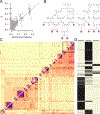Genetic characterization of a captive marmoset (Callithrix jacchus) colony using genotype-by-sequencing
- PMID: 38655843
- PMCID: PMC11182716
- DOI: 10.1002/ajp.23630
Genetic characterization of a captive marmoset (Callithrix jacchus) colony using genotype-by-sequencing
Abstract
The marmoset is a fundamental nonhuman primate model for the study of aging, neurobiology, and many other topics. Genetic management of captive marmoset colonies is complicated by frequent chimerism in the blood and other tissues, a lack of tools to enable cost-effective, genome-wide interrogation of variation, and historic mergers and migrations of animals between colonies. We implemented genotype-by-sequencing (GBS) of hair follicle derived DNA (a minimally chimeric DNA source) of 82 marmosets housed at the Southwest National Primate Research Center (SNPRC). Our primary goals were the genetic characterization of our marmoset population for pedigree verification and colony management and to inform the scientific community of the functional genetic makeup of this valuable resource. We used the GBS data to reconstruct the genetic legacy of recent mergers between colonies, to identify genetically related animals whose relationships were previously unknown due to incomplete pedigree information, and to show that animals in the SNPRC colony appear to exhibit low levels of inbreeding. Of the >99,000 single-nucleotide variants (SNVs) that we characterized, >9800 are located within gene regions known to harbor pathogenic variants of clinical significance in humans. Overall, we show the combination of low-resolution (sparse) genotyping using hair follicle DNA is a powerful strategy for the genetic management of captive marmoset colonies and for identifying potential SNVs for the development of biomedical research models.
Keywords: Callithrix jacchus; biomedical research; captive nonhuman primates; genetic ancestry; hair follicle DNA; pedigree.
© 2024 Wiley Periodicals LLC.
Conflict of interest statement
Figures


Similar articles
-
The genomic legacy of selectively breeding rhesus macaques for HIV/AIDS-related research.bioRxiv [Preprint]. 2025 May 28:2025.05.26.654976. doi: 10.1101/2025.05.26.654976. bioRxiv. 2025. PMID: 40501981 Free PMC article. Preprint.
-
Pharmacotherapy for smoking cessation: effects by subgroup defined by genetically informed biomarkers.Cochrane Database Syst Rev. 2017 Sep 8;9(9):CD011823. doi: 10.1002/14651858.CD011823.pub2. Cochrane Database Syst Rev. 2017. Retraction in: Cochrane Database Syst Rev. 2021 Nov 30;11:CD011823. doi: 10.1002/14651858.CD011823.pub3. PMID: 28884473 Free PMC article. Retracted.
-
Exploring and validating the marmoset as a primate model for chromosomal instability in early development.Mol Hum Reprod. 2025 Apr 3;31(2):gaaf012. doi: 10.1093/molehr/gaaf012. Mol Hum Reprod. 2025. PMID: 40193493
-
NIH Consensus Statement on Management of Hepatitis C: 2002.NIH Consens State Sci Statements. 2002 Jun 10-12;19(3):1-46. NIH Consens State Sci Statements. 2002. PMID: 14768714
-
Age-Related Changes in Marmoset (Callithrix jacchus) Feeding Behavior and Physiology: Insights of Masticatory and Swallowing Functions.Am J Primatol. 2025 Aug;87(8):e70070. doi: 10.1002/ajp.70070. Am J Primatol. 2025. PMID: 40855837 Free PMC article.
Cited by
-
Whole Genome Analysis of SNV and Indel Polymorphism in Common Marmosets (Callithrix jacchus).Genes (Basel). 2023 Dec 7;14(12):2185. doi: 10.3390/genes14122185. Genes (Basel). 2023. PMID: 38137007 Free PMC article.
References
-
- Abbott DH, Barnett DK, Colman RJ, Yamamoto ME, & Schultz-Darken NJ (2003). Aspects of common marmoset basic biology and life history important for biomedical research. Comparative medicine, 53(4), 339–350. - PubMed
-
- Alexander DH, Shringarpure SS, Novembre J, & Lange K. (2015). Admixture 1.3 software manual. Los Angeles: UCLA Human Genetics Software Distribution.
-
- Benirschke K, Anderson JM, & Brownhill LE (1962). Marrow chimerism in marmosets. Science, 138(3539), 513–515. - PubMed
MeSH terms
Grants and funding
LinkOut - more resources
Full Text Sources

